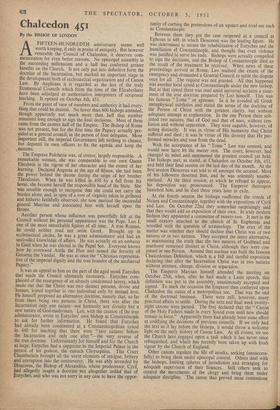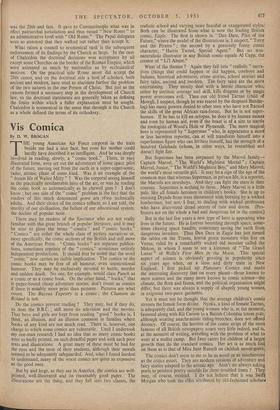Chalcedon 451
By the BISHOP OF LONDON FIFTEEN-HUNDREDTH anniversary seems well worth keeping, if only in praise of antiquity. But however venerable the Council of Chalcedon, it deserves com- memoration for even better reasons. No episcopal assembly in the succeeding millennium and a half has conferred greater benefits on the Church. It not only put into definitive form the doctrine of the Incarnation, but marked an important stage in the development both of ecclesiastical organisation and of Canon Law. By Anglicans it is regarded as the last of the truly Ecumenical Councils which from the time of the Elizabethans have been adjudged as authoritative interpreters of scriptural teaching. It opened on October 8th, 451.
From the point of view of numbers and authority it had every- thing that could be desired. No fewer than 600 bishops attended, though apparently not much more than half that number remained long enough to sign the final decisions. Most of them came from the eastern half of the Empire. The Bishop of Rome was not present, but for the first time the Papacy actually pre- sided at a general council, in the person of four delegates. More important still, the imperial Government left nothing to chance,, but deputed its own officers to fix the agenda and keep the minutes.
The Empress Pulcheria was, of course, largely responsible. A remarkable woman, she was comparable to our own Queen Elizabeth in the vigour of her character and the extent of her learning. Declared Augusta at the age of fifteen, she had been the power behind the throne during the reign of her brother Theodosius. When he was killed in 450 by a fall from his horse, she became herself the responsible head of the State. She was sensible enough to recognise that she could not carry the burden alone, and, in spite of a vow of virginity taken in girlhood and hitherto faithfully observed, she now married the successful general Marcian and associated him with herself upon the throne.
Another person whose influence was powerfully felt at the Council without his personal appearance was the Pope. Leo I, one of the most remarkable figures of all time. A true Roman, be could neither read nor write Greek. Brought up in ecclesiastical circles, he was a great administrator and had an unrivalled knowledge of affairs. He was actually on an embassy in Gaul when he was elected to the Papal See. Everyone knows bow he overawed Attila the Hun and tamed the ferocity of Genseric the Vandal. He was at once the "Christian representa- tive of the imperial dignity and the true founder of the mediaeval Papacy."
It was an appeal to him on the part of the aged monk Eutyches that made the Council ultimately necessary. Eutyches com- plained of the resurgence of an already condemned heresy, which made out that the Christ was two distinct persons, divine and 'human, joined together in one individual only by mutual love. He himself proposed an alternative doctrine, namely that, so far from there being two persons in Christ, there was after the Incarnation only one nature—not humanity nor divinity but a new nature of God-made:man. Leo, with the caution of the true administrator, wrote to Eutyches' own bishop at Constantinople to ask for further information. He found that Eutyches bad already been condemned at a Constantinopolitan synod in 448 for teaching that there were "two natures before the Incarnation and only one after "—the very reverse of the true doctrine. Unfortunately for himself and for the Church at large, Eutyches had a supporter in the Imperial Palace in the person of his godson, the eunuch Chrysaphius. This Court Chamberlain brought all the worst elements of intrigue, bribery and corruption into the controversy. He was ably seconded by Dioscorus, the Bishop of Alexandria, whose predecessor, Cyril, bad allegedly taught a doctrine not altogether unlike that of• Eutyches, and who was not sorry in any case to have the oppor- tunity of curbing the pretensions of an upstart and rival see such as Constantinople.
Between them they got the case reopened at a council at Ephesus in 449, in which Dioscorus was the leading figure. He was determined to secure the rehabilitation of Eutyches and the humiliation of Constantinople, and thought that even violence was justified to serve his ends. Bishops were actually compelled to sign the decisions, and the Bishop of Constantinople died as the result of the treatment he received. When news of these proceedings arrived at Rome, Leo realised the extent of the emergency and demanded a General Council to settle the dispute once for all. The request was not granted. All that happened was another local synod at Constantinople under the new bishop. But at that synod there was read amid universal acclaim a state- ment of the true doctrine prepared by Leo himself. This was his famous " Tome " or epitome. In it he avoided all Greek metaphysical subtleties and stated the terms of the doctrine of the Person of Christ with the greatest clarity, but without adequate attempt at explanation. In the one Person there sub- sisted two natures, that of God and that of man, without con- fusion and without separation. They were capable, however, of acting distinctly. It was in virtue of His humanity that Christ suffered and died ; it was in virtue of His divinity that He per- formed miracles and rose from the dead.
With the acceptance of his " Tome " Leo was content, and would now have let the matter rest. The court, however, had changed its mind and summoned the greatest council yet held. The bishops met, as stated, at Chalcedon on October 8th, 451, and held their final session on the last day of the month. At the first session Dioscorus was told to sit amongst the accused. Most of his followers deserted him, and he was solemnly anathe- matised. At the third session, at which he refused to appear, his deposition was pronounced. The Emperor thereupon banished him, and he died three years later in exile.
At the fourth session the bishops reaffirmed the creeds of Nicaea and Constantinople, together with the expositions of Cyril and Leo. On October 22nd they somewhat surprisingly said that they would add an exposition of their own. In truly modern fashion they appointed a committee of twenty-two. It met in the small oratory attached to the church of St. Euphemia and wrestled with the question of terminology. The crux of the matter was whether they should declare that Christ was of two natures or in two natures. They accepted the latter alternative, as maintaining the truth that the two natures of Godhead and manhood remained distinct in Christ, although they were con- joined in one Person. Around that nucleus was built the famous Chalcedonian Definition, which is a full and careful exposition declaring that after the Incarnation Christ was in two natures without mixture, change, division or separation.
The Emperor Marcian himself attended the meeting on October 25th, when, after he had made a Latin speech, this definition was put to the assembly, unanimously accepted and signed. To mark the occasion the Emperor then conferred upon Chalcedon the status of a metropolitan see. That was the end of the doctrinal business. There were still, however, many 'practical affairs to settle. During the next and final week twenty- eight canons were passed. The first declared that the "Canon of the Holy Fathers made in every Synod even until now should remain in force." Apparently there had already been some effort at codifying the decisions of previous councils. If we only had the text as it lay before the bishops, it would throw a welcome light on the early history of Canon Law. At all events, we see the Church here engaged upon a task which it has never since relinquished, and which has recently been taken up with fresh vigour by the Church of England.
Other canons regulate the life of monks, seeking (unsuccess- fully) to bring them under episcopal control. Others deal with the bishops, limiting spheres of jurisdiction and arranging for adequatt supervision of their finances. Still others seek to control the movements of the clergy and bring them under adequate discipline. The canon that proved most contentious was the 28th and last. It gave to Constantinople what was in effect patriarchal jurisdiction and thus raised "New Rome" to an administrative level with "Old Rome." The Papal delegates were so annoyed that they walked out rather than accept it.
What raises a council to ecumenical rank is the subsequent endorsement of its findings by the Church at large. In the case of Chalcedon the doctrinal decisions won acceptance by all except some Churches on the border of the Roman Empire, which were animated as much by nationalist as by ecclesiastical motives. On the practical side Rome never did accept the 28th canon, and on the doctrinal side a host of scholars, both ancient and modern, have tried to elucidate further the problem of the two natures in the one Person of Christ. But just as the canons formed a necessary step in the development of Church law, so the doctrinal statements are generally taken as defining the limits within which a fuller explanation must be sought. Chalcedon is ecumenical in the sense that through it the Church as a whole defined the terms of its orthodoxy.






















































 Previous page
Previous page